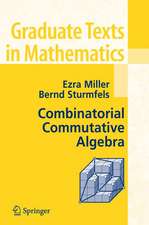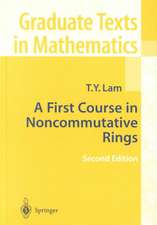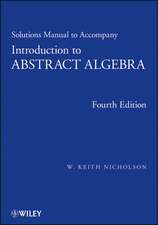Relativistic Quantum Mechanics and Introduction to Field Theory: Theoretical and Mathematical Physics
Autor Francisco J. Yndurainen Limba Engleză Paperback – 2 oct 2011
Din seria Theoretical and Mathematical Physics
- 20%
 Preț: 697.22 lei
Preț: 697.22 lei - 18%
 Preț: 744.84 lei
Preț: 744.84 lei - 20%
 Preț: 699.49 lei
Preț: 699.49 lei -
 Preț: 396.81 lei
Preț: 396.81 lei - 15%
 Preț: 721.06 lei
Preț: 721.06 lei - 18%
 Preț: 1120.68 lei
Preț: 1120.68 lei -
 Preț: 398.35 lei
Preț: 398.35 lei - 15%
 Preț: 643.65 lei
Preț: 643.65 lei - 15%
 Preț: 508.60 lei
Preț: 508.60 lei - 20%
 Preț: 652.54 lei
Preț: 652.54 lei - 15%
 Preț: 646.75 lei
Preț: 646.75 lei - 15%
 Preț: 654.12 lei
Preț: 654.12 lei - 15%
 Preț: 649.87 lei
Preț: 649.87 lei -
 Preț: 396.24 lei
Preț: 396.24 lei - 15%
 Preț: 653.14 lei
Preț: 653.14 lei - 18%
 Preț: 960.78 lei
Preț: 960.78 lei - 15%
 Preț: 529.92 lei
Preț: 529.92 lei - 18%
 Preț: 1127.78 lei
Preț: 1127.78 lei - 18%
 Preț: 1554.09 lei
Preț: 1554.09 lei - 15%
 Preț: 551.53 lei
Preț: 551.53 lei - 18%
 Preț: 1002.75 lei
Preț: 1002.75 lei -
 Preț: 396.02 lei
Preț: 396.02 lei - 15%
 Preț: 648.89 lei
Preț: 648.89 lei - 18%
 Preț: 783.35 lei
Preț: 783.35 lei - 18%
 Preț: 973.38 lei
Preț: 973.38 lei - 18%
 Preț: 907.90 lei
Preț: 907.90 lei - 15%
 Preț: 655.78 lei
Preț: 655.78 lei - 18%
 Preț: 1118.93 lei
Preț: 1118.93 lei -
 Preț: 390.25 lei
Preț: 390.25 lei - 15%
 Preț: 663.79 lei
Preț: 663.79 lei - 15%
 Preț: 653.79 lei
Preț: 653.79 lei - 15%
 Preț: 645.28 lei
Preț: 645.28 lei - 15%
 Preț: 604.23 lei
Preț: 604.23 lei - 15%
 Preț: 639.25 lei
Preț: 639.25 lei - 15%
 Preț: 590.81 lei
Preț: 590.81 lei -
 Preț: 395.25 lei
Preț: 395.25 lei - 15%
 Preț: 589.33 lei
Preț: 589.33 lei - 19%
 Preț: 543.18 lei
Preț: 543.18 lei - 15%
 Preț: 594.24 lei
Preț: 594.24 lei - 18%
 Preț: 916.57 lei
Preț: 916.57 lei - 18%
 Preț: 957.75 lei
Preț: 957.75 lei -
 Preț: 409.13 lei
Preț: 409.13 lei - 15%
 Preț: 532.23 lei
Preț: 532.23 lei
Preț: 473.66 lei
Preț vechi: 557.25 lei
-15% Nou
Puncte Express: 710
Preț estimativ în valută:
90.64€ • 93.50$ • 75.64£
90.64€ • 93.50$ • 75.64£
Carte tipărită la comandă
Livrare economică 26 martie-09 aprilie
Preluare comenzi: 021 569.72.76
Specificații
ISBN-13: 9783642646744
ISBN-10: 3642646743
Pagini: 348
Ilustrații: XII, 332 p.
Dimensiuni: 155 x 235 x 18 mm
Greutate: 0.49 kg
Ediția:Softcover reprint of the original 1st ed. 1996
Editura: Springer Berlin, Heidelberg
Colecția Springer
Seria Theoretical and Mathematical Physics
Locul publicării:Berlin, Heidelberg, Germany
ISBN-10: 3642646743
Pagini: 348
Ilustrații: XII, 332 p.
Dimensiuni: 155 x 235 x 18 mm
Greutate: 0.49 kg
Ediția:Softcover reprint of the original 1st ed. 1996
Editura: Springer Berlin, Heidelberg
Colecția Springer
Seria Theoretical and Mathematical Physics
Locul publicării:Berlin, Heidelberg, Germany
Public țintă
Lower undergraduateCuprins
1. Relativistic Transformations. The Lorentz Group.- 1.1 Rotations, and Space and Time Reversal for Particles with Spin.- 1.2 Galilean Transformations.- 1.3 Lorentz Transformations. Normal Parameters.- 1.4 Minkowski Space. The Full Lorentz Group.- 1.5 The Lorentz Group.- 1.6 Geometry of Minkowski Space.- 1.7 Transformation Properties of Physical Quantities Under the Lorentz Group.- 1.8 Covariant Form of the Maxwell Equations.- 1.9 Minkowski Space: Metric, Conventions.- 2. The Klein—Gordon Equation. Relativistic Equation for Spinless Particles.- 2.1 The Klein—Gordon Equation. Generalities.- 2.2 Wave Equation for Free Spinless Particles.- 2.3 Plane Waves. Current. Scalar Product.- 2.4 Interaction with the Classical Electromagnetic Field. Gauge Invariance.- 2.5 Particle in a Coulomb Field.- 3. Spin 1/2 Particles.- 3.1 The Dirac Equation.- 3.2 Invariance Properties of the Dirac Equation.- 3.2.1 Rotations.- 3.2.2 Boosts.- 3.2.3 Parity.- 3.2.4 Time Reversal.- 3.3 Density of Particles. Current. Scalar Product.- 3.4 Minimal Replacement. Gauge Invariance. Large and Small Components: Nonrelativistic Limit of the Dirac Equation....- 3.5 Plane Waves. States with Weil-Defined Spin.- 3.6 Radial Form of the Dirac Equation. Free-Particle Solutions.- 3.6.1 Radial Form of H.- 3.6.2 Free Particles.- 3.7 The Problem of Negative Energies in the Dirac Equation. The Dirac Sea. Hole Theory. Charge Conjugation.- 3.7.1 Negative Energies. The Dirac Sea. Holes.- 3.7.2 Charge Conjugation.- 3.8 Covariants and Projectors.- 3.8.1 Covariants.- 3.8.2 Projectors.- 3.9 Massless Spin 1/2 Particles.- 4. Dirac Particle in a Potential.- 4.1 Dirac Particle in a Spherical Well.- 4.2 Particle in a Coulomb Potential: Continuum States.- 4.3 Scattering States. Phase Shifts. Cross-sections. Wave Function at theOrigin.- 4.3.1 Scattering States. Phase Shifts.- 4.3.2 Cross-sections.- 4.3.3 Wave Function at the Origin.- 4.4 Bound States in a Coulomb Potential.- 4.5 Semirelativistic Approximation: the Foldy—Wouthuysen Transformation.- 4.5.1 General Method.- 4.5.2 Electromagnetic Interactions.- 4.5.3 Free Particle.- 5. Massive Particles with Spin 1. Massless Spin 1 Particle: Photon Wave Functions. Particles with Higher Spins (3/2, 2,…).- 5.1 Particle with Spin 1 and Mass m ? 0.- 5.2 Particle with Spin 1 and Zero Mass: The Photon. Plane Waves. Photon Spin.- 5.2.1 Photon Wave Function. Gauge Fixing. Transformation Properties.- 5.2.2 Plane Waves. Helicity States.- 5.2.3 Field Variables as Wave Functions for the Photon. The Schwinger Gauge.- 5.3 Angular Momentum Eigenstates for the Photon. Vector Spherical Harmonics. Multipoles.- 5.3.1 General Useful Formulas.- 5.3.2 Multipoles.- 5.3.3 Photon Wave Functions with Well-Defined Angular Momentum.- 5.4 Particles with Higher Spins. Rarita—Schwinger and Bargmann—Wigner Equations. The Graviton.- 5.4.1 Rarita—Schwinger Equations.- 5.4.2 Bargmann—Wigner Equations.- 5.4.3 The Graviton.- 6. General Description of Relativistic States.- 6.1 Preliminaries.- 6.2 Relativistic One-Particle States: General Description.- 6.3 Relativistic States of Massive (m?0) Particles.- 6.4 Massless Particles.- 6.5 Many-Particle States. Creation—Annihilation Operators. Fock Space.- 6.6 Connection with the Wave Function Formalism.- 7. General Description of Relativistic Collisions: S Matrix, Cross-sections and Decay Rates. Partial Wave Analyses.- 7.1 Two-Particle States. Separation of the Centre of Mass Motion. States with Weil-Defined Angular Momentum.- 7.2 Kinematics of Two-Particle Collisions.- 7.3 The S Matrix. Scattering Amplitude.Nonrelativistic Limit.- 7.4 Cross-sections and Decay Rates. The Optical Theorem.- 7.5 Partial Wave Analysis and Phase Shifts. I. Spinless Elastic Scattering. Effective Range Expansion....- 7.5.1 Partial Wave Analysis.- 7.5.2 Effective Range Formalism.- 7.6 Partial Wave Analysis. II. Several Two-Body Channels.- 7.6.1 Multichannel Analysis.- 7.6.2 Effective Range Approximation.- 7.7 Partial Wave Analysis. III. Particles with Spin.- 7.7.1 Spin Analysis.- 7.7.2 Scattering of Spin 0 - Spin 1/2 Particles.- 7.8 Evaluation of the S Matrix.- 7.8.1 The S Matrix and the Interaction Picture.- 7.8.2 The S Matrix in the Lippmann-Schwinger Formalism..- 7.8.3 Scattering by Two Interactions.- 8. Quantization of the Electromagnetic Field. Interaction of Radiation with Matter.- 8.1 Normal, or Wick, Products.- 8.2 Quantization of the Electromagnetic Field (Coulomb Gauge). The Casimir Effect.- 8.2.1 Quantization of the Electromagnetic Field.- 8.2.2 Multipole Expansion.- 8.2.3 The Casimir Effect.- 8.3 Interaction of the Radiation with Slowly Moving Particles....- 8.3.1 Radiative Decays, and Absorption of Radiation.- 8.3.2 Low-Energy Compton Scattering.- 8.4 Bremsstrahlung.- 8.5 The Classical Limit. Coherent States.- 8.6 Uncertainty Relations for Field Variables.- 9. Quantum Fields: Spin 0, 1/2, 1. Covariant Quantization of the Electromagnetic Field.- 9.1 Generalities.- 9.2 Localization of Particles in Relativistic Quantum Mechanics..- 9.3 Retardation and Consistency.- 9.4 Quantization of Scalar Fields and of Massive Vector Fields....- 9.4.1 Second Quantization for Spinless Particles.- 9.4.2 Massive Vector Particles.- 9.5 Quantization of the Dirac Field. Weyl and Majorana Particles.- 9.6 Covariant Quantization of the Electromagnetic Field.- 9.6.1 The Gupta-Bleuler Space.- 9.6.2 Covariant Transformation.- 9.6.3 The Metric Operator Method.- 9.7 Time-Ordered Product. Propagators.- 9.8 Interactions in Quantum Field Theory. Lagrangian Formulation.- 9.8.1 Lagrangian Formalism for Fields.- 9.8.2 Interactions.- 9.9 Gauge Invariance in Quantum Electrodynamics.- 10. Interactions in Quantum Field Theory. Nonrelativistic Limit. Reduction to Equivalent Potential.- 10.1 Potentials Equivalent to Field-Theoretic Interactions. General Method.- 10.2 Equivalent Potential for Two Particles in Electromagnetic Interaction.- 10.2.1 Elastic Collision of Two Charged Particles in the Born Approximation.- 10.2.2 Nonrelativistic Limit.- 10.2.3 Relativistic Corrections. The Breit Term.- 10.3 Hydrogenlike Atoms: Hyperfine Structure. System with Two Electrons: the Helium Atom.- 10.3.1 Hydrogenlike Atoms.- 10.3.2 System With Two Electrons. The Helium Atom.- 10.4 Electron-Positron Collisions: Effective Potential. Positronium.- 10.4.1 Scattering Amplitude in the Born Approximation..- 10.4.2 Annihilation Channel.- 10.4.3 Positronium.- 10.5 Scalar and Pseudoscalar Interactions. The Yukawa Potential..- 10.6 Weak Neutral Currents. Parity Violation in Atoms.- 11. Relativistic Collisions in Field Theory. Feynman Rules. Decays.- 11.1 Electron-Positron Annihilation into Two Photons, and Pair Creation by Two-Photon Collisions.- 11.1.1 e+e- Annihilation into 2?.- 11.1.2 Creation of an e+e- Pair by Two Photons.- 11.2 Feynman Rules. Gauge Invariance.- 11.2.1 Feynman Rules for the Evaluation of Transition Amplitudes.- 11.2.2 Gauge Invariance.- 11.3 Polarized and Unpolarized Cross-sections. Sums Over Polarizations.- 11.4 Compton Scattering (Relativistic).- 11.5 Decay of Bound States.- 11.5.1 General Theory.- 11.5.2 Decays of Positronium.- 11.5.3 Decay of Muonium into e+e-. Decays of Quarkonium.- 12.Relativistic Interactions with Classical Sources.- 12.1 Interaction with a Fixed (Classical) Potential.- 12.1.1 Scattering by an External Field.- 12.1.2 Bremsstrahlung.- 12.2 Photon Emission by a Classical Source. The Bloch-Nordsieck Theorem. Classical Limit.- 12.2.1 Classical Radiation.- 12.2.2 Photon Emission by a Classical Current.- 12.2.3 Radiation of Coherent States.- 12.2.4 The Bloch—Nordsieck Theorem.- 12.3 Propagation of an Electron in a Classical Potential. The Proper-Time Method.- 12.3.1 Electron in a Coulomb Potential.- 12.3.2 The Proper-Time Method.- 12.3.3 Dirac Particle in a Constant Field, or in a Plane Wave.- Appendices.- A.1 Spherical Harmonics, Clebsch—Gordan Coefficients, Matrix Representations of the Rotation Group.- A.1.1 Spherical Harmonics.- A.1.2 Some Specific Values.- A.1.3 Multiplication Formulas.- A.1.4 Gegenbauer-like Formulas.- A.1.5 Spinor and Vector Spherical Harmonics.- A.1.6 Clebsch—Gordan Coefficients.- A.1.7 Rotation Matrices.- A.2 Special Functions.- A.2.1 Kummer, or Confluent Hypergeometric Functions.- A.2.2 Bessel Functions.- A.2.3 Spherical Bessel Functions.- A.2.4 Bessel Functions of the Second Kind.- A.2.5 Laguerre Polynomials.- A.4 ? Matrices.- A.4.1 The Pauli Realization.- A.4.2 The Weyl Realization.- A.4.3 The Majorana Realization.- A.6 Physical Quantities.- A.6.1 SI (Gauss) Units.- A.6.3 Other Relations.- References.














